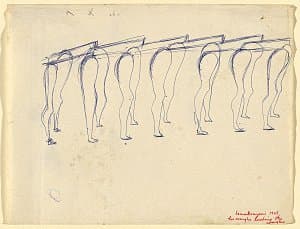

Louise Bourgeois
Learn moreLes aveugles leading the aveugles [The blind leading the blind] 1968
© The Easton Foundation. VAGA/Copyright Agency Purchased 1981
More detail | PermalinkLouise Bourgeois traced the genesis of two of her earliest major works, C.O.Y.O.T.E. and The blind leading the blind, to childhood memories, when she and her brother crouched beneath the kitchen table watching the legs of their parents move back and forth as they prepared a meal.[i] Referring specifically to this work, she said:
It represents an army of legs, two by two, that holds together. Eight pairs of legs. The reason this blind army of legs does not fall, even though the legs are always afraid of falling, since they come to a point, is that they hold on to each other. This is exactly what I felt when I was a child, when I was hiding under the table. My brother was following me like a shadow; I was blind with fear and so was he … [and I concluded that my parents] were not friendly. I decided that the outside was not friendly. And I was afraid, simply afraid. I couldn’t understand their purpose, which was to prepare lunch. I didn’t understand why they were walking around the table. Why would one pair of legs interfere with the other visually, physically? There were their legs and the table’s legs. It really just made me wonder where I fitted in.[ii]
If the form of these sculptures owed something to childhood memories, their title The blind leading the blind—a title that was also originally applied to C.O.Y.O.T.E.—had a very contemporary relevance for Bourgeois. Taken from the New Testament (Matthew 15:14: ‘if the blind lead the blind, both shall fall into the ditch’), the title was chosen for works in which the artist saw ‘catastrophe’, ‘a chain of pain’, ‘people fated to be destroyed together’.[iii] The sculptures were made at the height of the Cold War, at a time when her friends, the artists Marcel Duchamp, Amédée Ozenfant and André Lhote, were under investigation by the House Un-American Activities Committee, suspected of being Communists.
Two ballpoint pen sketches on the theme of The blind leading the blind, both dating to 1968, suggest the evolution of the artist’s thinking. One of them, inscribed ‘les aveugles leading the / aveugles’, is composed of a series of mannequin-type legs with ‘beams’ to join them in pairs. The second drawing, The blind, retains the seven pairs of legs, but this time Bourgeois’ ‘army’ appears rather more militaristic.
Christine Dixon[iv]
[i] Kay Larson, ‘Louise Bourgeois: Body language spoken here’, Village Voice, 24–30 September 1980, p 83.
[ii] Donald Kuspit, Bourgeois: an interview with Louise Bourgeois, Vintage Books, New York, 1988, pp 26–7.
[iii] Lippard, p 27.
[iv] Adapted and updated from Michael Lloyd and Michael Desmond, European and American Paintings and Sculptures 1870–1970 in the Australian National Gallery, Australian National Gallery, Canberra, 1992, pp 209–11.

